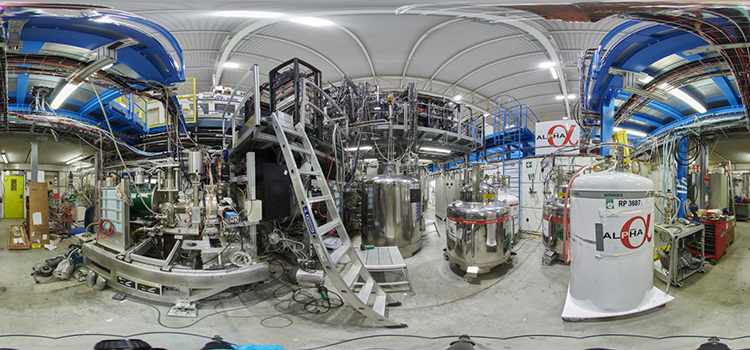ALPHA collaboration researchers successfully laser cool antimatter hydrogen atoms
2021-03-31
Panorama in the CERN Antiproton Decelerator hall containing several experiments including ALPHA (Image: CERN).
The ALPHA collaboration reported the first successful cooling of atomic antimatter using ultraviolet light in the April 1, 2021 volume of Nature. This accomplishment, which will allow for more precise determination of the properties of antihydrogen and, possibly, the first measurement of the force of gravity on antimatter, resulted from a decade long development in the trapping of antimatter hydrogen and in laser technology. To date, the gravitational force on antimatter has never been measured so ALPHA scientists are excited by the prospect of determining the gravitational force on cold antimatter hydrogen. Also, by more precisely measuring the properties of antimatter hydrogen, ALPHA scientists hope to contribute to understanding the matter-antimatter asymmetry in the universe.
Dr. Francis Robicheaux, professor in the Department of Physics and Astronomy at Purdue University, was involved in this research as part of the ALPHA collaboration since 2005. Antimatter hydrogen atoms, first trapped by the ALPHA collaboration in 2010, are ideal for many studies due to their simplicity, consisting of one antimatter proton and one antimatter electron. Colder atoms greatly improve measurements by slowing down their motion. However, cooling antimatter by putting it in contact with cold matter won't work because antimatter annihilates when it touches matter.
Robicheaux says "It was obvious to many that laser cooling was a very promising method." Laser cooling of regular atoms has been an important technique in many labs for 40 years. "In 2012 when I was a professor at Auburn University, a fantastic undergraduate researcher (Patrick Donnan), a colleague (Makoto Fujiwara of Triumf), and I performed large simulations of laser cooling in the ALPHA antimatter trap and we showed substantial cooling was possible. The ALPHA collaboration developed the laser that could be used to do just that. This was an incredibly difficult experiment because of the constraints (temperatures just above absolute zero, enormous magnetic fields, high energy laser, and more) but they succeeded in removing more than 90% of the energy from the trapped antihydrogen, considerably slowing them down."
Colder antimatter hydrogen atoms open the possibility for measuring the force of gravity on antimatter for the first time. Most scientists expect gravity will work the same for matter and antimatter but this has never been tested. Robicheaux explains, "for large objects like us, gravity is usually the most important force and is easy to measure. For tiny objects, almost all forces are much larger than from gravity meaning the effects from gravity are hard to isolate. Fast antihydrogen would just fly out of the trap in any direction whereas we want to see them fall due to gravity, slowing antihydrogen is a key improvement."
Another goal of the ALPHA collaboration is to compare properties of regular hydrogen atoms to those of antimatter hydrogen. A huge mystery is the matter-antimatter asymmetry of the universe. Almost everything in the universe is matter whereas our current understanding of the universe would lead to comparable amounts of matter and antimatter. Robicheaux said, "by studying the antimatter version of the simplest atom, hydrogen, at very high precision, we hope to get some hints about the reason for this basic fact." Colder antihydrogen greatly improves precision because they move more slowly through the measuring region. As a first test, ALPHA reported in the Nature article that the measured spread in frequencies decreased by about 4 times for the laser cooled antihydrogen.
Robicheaux has been a professor at Purdue University since Fall 2013 and is a theorist who performs computer simulations for situations involving atoms or nanometer size objects. Currently, one Purdue undergraduate, Andrew Gustafson (a Goldwater scholar), collaborates with Robicheaux on antimatter simulations. Robicheaux says, "Andrew's projects look to the future of ALPHA experiments. One project, which he has already completed, predicts how experiments will behave with colder antihydrogen. I'm sure his results will be used in the next few years to understand ALPHA measurements."
This work is supported by the US National Science Foundation under Grant No. 1806380-PHY.
Written by Cheryl Pierce with contritbutions from Dr. Francis Robicheaux. Contact info here. Info page here.
